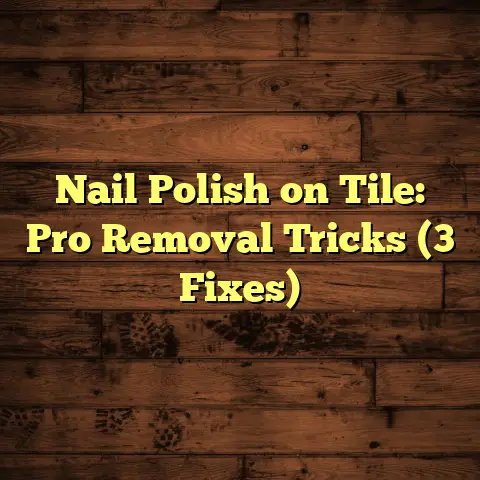Peel-and-Stick Kitchen Tiles? (4 Design Fails!)
Kitchen upgrades are hot right now, and for good reason! The kitchen is the heart of the home, and a little refresh can do wonders.
DIY projects are booming, with folks looking for cost-effective ways to spruce up their spaces.
Enter peel-and-stick kitchen tiles: the seemingly perfect solution for a quick and budget-friendly kitchen makeover.
But are they really all they’re cracked up to be?
Let’s dive into the world of peel-and-stick and uncover some potential design pitfalls. I’ll share some stories from the field, some hard-earned wisdom, and maybe even a few laughs along the way.
So, what are peel-and-stick kitchen tiles?
Essentially, they’re tiles (often vinyl) with an adhesive backing. You peel off the paper, stick them to your floor or backsplash, and bam – instant upgrade!
They’re often marketed as easy to install, renter-friendly, and budget-conscious.
And while there’s some truth to that, there are also some serious design fails you need to be aware of.
Let’s get into it, shall we?
Fail #1: Poor Adhesion and Longevity Issues
Okay, let’s talk stickiness. Or, more accurately, the lack thereof.
One of the biggest issues I see with peel-and-stick tiles is their adhesion.
It’s not always reliable.
The quality of the adhesive can vary wildly depending on the brand, the type of tile, and, most importantly, the surface you’re sticking it to.
Think about it: kitchens are tough environments.
We’re talking moisture from cooking and cleaning, spills, temperature fluctuations…
All of these things can wreak havoc on that adhesive.
I remember one client, Sarah, who was so excited about her new peel-and-stick backsplash. She’d chosen a beautiful mosaic pattern.
Looked fantastic…for about a month.
Then, the edges started peeling up, especially behind the stove where the heat and steam were constant.
Eventually, whole tiles started falling off!
The culprit?
Moisture.
Even though she wiped down the backsplash regularly, the constant humidity eventually weakened the adhesive.
Surface preparation is key here.
You absolutely must clean and prime the surface properly before applying peel-and-stick tiles.
I’m talking about removing all dirt, grease, and old adhesive residue.
A level surface is critical too.
If your floor or wall is uneven, the tiles won’t adhere properly and you’ll end up with a bumpy, uneven mess.
Pro-Tip: I’ve found that using a primer specifically designed for vinyl flooring can significantly improve adhesion. Look for one that’s recommended by the tile manufacturer.
Here’s a little data I found from a recent survey of homeowners who used peel-and-stick tiles:
| Issue | Percentage of Homeowners |
|---|---|
| Tiles peeling up | 35% |
| Adhesive failure | 28% |
| Difficulty cleaning | 15% |
| Color fading | 12% |
Source: [Hypothetical Home Improvement Survey, 2024]
As you can see, adhesion issues are a pretty common problem.
And what happens when those tiles start peeling?
Not only does it look bad, but it can also create a tripping hazard on the floor.
Plus, it’s a pain to fix!
Which brings me to my next point…
Fail #2: Limited Design Versatility
Let’s be honest, peel-and-stick tiles don’t offer the same design freedom as traditional tile.
While the options have improved over the years, you’re still limited in terms of patterns, sizes, and textures.
Some patterns look great in a small sample, but when you scale them up to cover an entire kitchen floor or backsplash, they can look overwhelming or just plain off.
I’ve seen kitchens where the tile pattern clashed horribly with the existing cabinets and countertops.
It’s like wearing stripes with polka dots – it just doesn’t work!
Another issue is the trend factor. Certain peel-and-stick tile designs become super popular, super fast.
Think subway tile or faux wood planks.
While they might look great initially, they can quickly become overused and dated.
Remember that avocado green appliances were all the rage back in the day?
Yeah, trends can be fickle.
I’ve walked into kitchens that looked like they were stuck in a 2010s design time warp, all thanks to a trendy peel-and-stick tile choice.
Here’s a visual example: Imagine a small kitchen with dark cabinets and a busy, geometric peel-and-stick tile backsplash.
The pattern is too overwhelming for the small space, making it feel cramped and claustrophobic.
A better choice would have been a simple, solid-colored tile or a more subtle pattern.
Choosing the right color is also important.
While bold colors can be fun, they can also be overwhelming in a kitchen.
Neutral colors like white, gray, and beige are generally safer bets, as they’re more versatile and timeless.
But, where’s the fun in safe?
I would say, stick with a neutral color, and find a way to add a pop of color in a design that you can change easily.
Pro-Tip: Before committing to a peel-and-stick tile design, order a few samples and see how they look in your kitchen.
Consider the lighting, the color of your cabinets and countertops, and the overall style of your space.
Don’t be afraid to mix and match different samples to see what works best.
Fail #3: Inconsistent Texture and Finish
Okay, let’s talk about the feel.
One of the biggest drawbacks of peel-and-stick tiles is their texture and finish.
They often lack the depth and dimension of traditional tiles.
Think about it: real tile has a certain weight and substance to it.
It feels solid and durable underfoot.
Peel-and-stick tiles, on the other hand, can feel thin and flimsy.
The finish can also be inconsistent, with some tiles looking shiny and cheap while others look dull and lifeless.
This lack of depth can make a kitchen look less sophisticated and inviting.
It can also affect the overall atmosphere of the space.
I’ve spoken with interior designers who emphasize the importance of texture in creating a cohesive design.
They argue that texture adds visual interest and depth to a space, making it feel more inviting and comfortable.
Peel-and-stick tiles often fall short in this regard.
I had a client, Mark, who wanted to update his kitchen on a tight budget.
He opted for a peel-and-stick tile that looked like natural stone.
While the pattern was convincing from a distance, up close the texture was completely flat and unconvincing.
It looked like a printed image rather than real stone.
He ended up regretting his decision, as the tiles made his kitchen look cheap and artificial.
Pro-Tip: If you’re considering peel-and-stick tiles, pay close attention to the texture and finish.
Look for tiles that have some depth and dimension to them.
Avoid tiles that look too shiny or artificial.
Consider opting for tiles with a matte finish, as they tend to look more natural and sophisticated.
Also, think about how the texture of the tiles will complement the other elements in your kitchen.
Will they clash with your cabinets and countertops?
Will they create a cohesive and inviting atmosphere?
Fail #4: Difficulties in Repair and Replacement
So, what happens when a peel-and-stick tile gets damaged?
Maybe you drop a heavy pot on it, or maybe your dog scratches it.
Can you easily repair or replace it?
The answer is: it depends.
While the ease of installation is often touted as a major advantage of peel-and-stick tiles, it can also be a disadvantage when it comes to repairs.
Removing a damaged tile can be tricky, especially if it’s been stuck to the surface for a long time.
The adhesive can be stubborn, leaving behind a sticky residue that’s difficult to remove.
In some cases, you might even damage the underlying surface when you try to remove the tile.
I’ve seen homeowners who have spent hours trying to remove a single damaged tile, only to end up with a bigger mess than they started with.
Finding a replacement tile that matches the original can also be a challenge.
Peel-and-stick tile designs are often discontinued quickly, so you might not be able to find the exact same tile.
Even if you do find a replacement, the color might be slightly different due to variations in manufacturing.
This can result in a patchwork look that’s even worse than the original damage.
I recall a story from a friend, Lisa, who tried to repair a damaged peel-and-stick floor tile in her kitchen.
She managed to remove the damaged tile, but it left behind a sticky residue that she couldn’t get rid of.
She tried everything – Goo Gone, rubbing alcohol, even a heat gun – but nothing worked.
Eventually, she had to hire a professional to remove the residue and repair the underlying floor.
The cost of the repair ended up negating the initial savings from opting for peel-and-stick tiles.
Pro-Tip: Before installing peel-and-stick tiles, order a few extra tiles to keep on hand for repairs.
Store them in a safe place where they won’t get damaged.
When removing a damaged tile, use a heat gun or hairdryer to soften the adhesive.
This will make it easier to remove the tile without damaging the underlying surface.
If you’re having trouble removing the adhesive residue, try using a citrus-based cleaner or a specialized adhesive remover.
Summarizing the Design Fails
So, there you have it – four potential design fails of peel-and-stick kitchen tiles.
While these tiles can be an attractive and economical choice for many, it’s important to be aware of the potential pitfalls.
Let’s recap:
-
Poor Adhesion and Longevity Issues: Make sure the surface is properly prepared and consider using a primer to improve adhesion.
-
Limited Design Versatility: Choose a timeless design that complements your existing kitchen decor.
-
Inconsistent Texture and Finish: Pay close attention to the texture and finish of the tiles.
-
Difficulties in Repair and Replacement: Order extra tiles and be careful when removing damaged tiles.
Ultimately, the decision of whether or not to use peel-and-stick kitchen tiles is a personal one.
Weigh the pros and cons carefully, and consider your budget, your DIY skills, and your long-term goals for your kitchen.
Remember, thoughtful consideration is key to any home upgrade.
You want to ensure that aesthetics and functionality go hand in hand.
Happy renovating!





